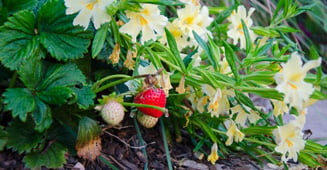

Contributor
- Topics: Archive

Put your hands in the soil and feel the dark, moist, gritty earth; smell the aroma of soil and plants and wake up to your surroundings. Sweat a little and enjoy the beautiful, tasty fruits of your labor.
Gardening connects us to nature. It also invites us to think like scientists. The garden is our laboratory where experimentation, observation, and evaluation are a part of the process.
Conventional gardening advice teaches us to compartmentalize and evaluate the garden through the lens of each particular problem. Once the pest or disease has been isolated and identified a targeted treatment is applied. What can we buy to make the powdery mildew go away or combat pesky white flies? Yet isolating a disease or a pest problem and treating it with a product often means harming other living organisms, bacteria, and beneficial forms of life that support the health of the garden and its plants.

At Mariposa, my landscape design/build firm, we look at the garden as a complete ecosystem. Each element in the landscape—soil, water, and plants—is a part of an organized and efficient system that contributes to the overall health and vigor of a garden. Pest problems are not treated as isolated incidences; aphids on the roses don’t necessarily require the latest spray treatment. We can boost the microbial activity in the soil which strengthens the rose bush so it can ward off pesky aphids, adjust irrigation so that the rose isn’t stressed by over- or under-watering, and the right companion plants, such as garlic or thyme, attract ladybugs and other beneficial insects that prey on aphids and help keep their numbers low. It is a multi-pronged approach that treats the entire garden, not just aphids on the rose. It is all interrelated.
In nature, everything is connected. When we unzip nature to use isolated solutions to our gardening problems we override the many dynamic associations that are interwoven throughout healthy natural systems. Designing and building an ecologically strong garden requires us to appreciate our connection to nature and understand how to care for the overall health of the garden. Our efforts to manage water, make good plant choices, and increase the diversity of living organisms in and above the soil, zips everything back together again to create a garden that is healthy and vibrant as well as drought-tolerant and disease- and pest-resistant.

Natural systems are complex, but creating an ecosystem-based garden doesn’t have to be. We frame it as building life in your garden both below and above the soil.

Soil Work
Soil is the medium that supports life in the garden. Increasing soil fertility in a healthy way contributes to the overall health of your plants. Garden soil has the potential to support an amazing and diverse network of beneficial living organisms from bacteria and mycorrhizae on a micro scale, to earthworms and beetles on a macro scale.
Increase your soil’s fertility by increasing the life in your soil. Compost and organic soil amendments provide food for beneficial soil organisms. More food increases microbial populations, resulting in increased enzymes and microbial waste, which promote plant health, vigor, and growth; resilience to disease and pest infestations; and increased drought tolerance.
Begin to increase beneficial soil organisms by applying fish emulsion to the garden every week. Switch to once a month as the health of your garden improves along with quarterly additions of organic amendments like kelp, blood and bone meals, ground feathers, rock dust, oyster shells, and an annual blanket of compost. Most garden centers carry blends of organic amendments specially formulated for specific garden needs like vegetables, blooming plants, or acid-loving plants and berries.

Encouraging Life Above the Soil
Combining plants in ways we can see in nature creates more life and living connections above the soil. Habitat gardens provide food, water, and shelter to a diverse array of living creatures such as butterflies, dragonflies, beneficial wasps, predatory insects such as ladybugs, and pollinators such as honeybees and native mason bees and bumblebees. Fostering a diversity of species creates balance in the garden. If aphids appear in the garden, there are ladybugs are there to keep their populations in check.
We work to build life above the soil by planting densely. A foundation of native grasses, such as Sporobolus airoides and Danthonia californica, and the sedge, Carex pansa, provide shelter for a vast array of pollinator species. Next to these we plant nectar plants with long bloom times, such as Penstemon and Salvia. Then we add nectar plants with early bloom times, such as miner’s lettuce (Claytonia perfoliata), manzanita (Arctostaphylos sp.) and Ribes, and mix in late-blooming nectar plants such as Epilobium (syn. Zauschneria), Galvezia, and native roses. To literally top things off, we layer in trees and shrubs creating “ladders” that allow birds to move up and down and throughout the garden sheltered from predators like cats. We add plants that will provide winter interest, such as native grapes and coffeeberry (Frangula californica, syn. Rhamnus californica), whose red berries hold into winter and provide nutrients for birds. Native strawberries (Fragaria vesca ssp. californica) and herbs such as thyme create a naturally drought- tolerant and lush groundcover that provides food for beneficial insects, birds, and people, too.

Native Plants
Using native plants in the garden is an effective way to create a beautiful garden that mimics natural systems and provides a net gain for the environment. Because they are adapted to local conditions, including life above and below the soil, native plants require less additional water (once they are established) and are more resistant to pests and disease. Natives also provide food and shelter for birds, butterflies, bees, and other beneficial insects. However, because native plants are such sturdy performers under garden conditions where other plants might die, their care is often neglected.
It is commonly believed that many natives can’t handle fertile soil or additional irrigation. I’ve been gardening with native plants for more than 20 years in the Northwest, the Southwest, the Northeast, and the San Francisco Bay Area. During that time, I’ve learned to build lush, beautiful, ecologically sound gardens using a primarily native plant palette by using this ecosystem approach to design. At Mariposa, we treat natives just as we do all other garden plants. We build fertility in the soil with a rigorous schedule of adding compost and organic amendments, as described opposite. Soil filled with lively microbes and plants that are allowed to mingle like they would in nature results in a healthy, robust garden that requires less water, rather than one that looks starved and deprived.

Designing gardens with an eye toward creating ecological diversity is a framework that prompts us to consider all of the individual elements at work in nature and weave them together in a finished space.
Andrea Hurd and Mariposa Gardening & Design are committed to creating beautiful and innovative ecological living spaces.

Share:
Social Media
Garden Futurist Podcast
Most Popular
Videos
Topics
Related Posts

Low Maintenance Gardens – Better for Pollinators and People
Autumn 2022 “I come out every day. It’s therapy, my meditation.” Janet’s young garden transformed from overgrown, invasive plants to mostly natives. The dailiness of

Invasive Plants Are Still Being Sold: Preventing Noxious Weeds in Your Landscape
Autumn 2022 With so many beautiful ornamental plant species and cultivars throughout California and the Pacific Northwest, how do you decide which ones to include

Garden Design in Steppe with Transforming Landscapes with Garden Futurist Emmanuel Didier
Summer 2022 Listen to full Garden Futurist: Episode XVII podcast here. Emmanuel Didier, Principal and Creative Director at Didier Design Studio is a leading figure

Seslerias: Versatile Groundcover Meadow Grasses
Summer 2022 Without question, the most beautiful and versatile of all the groundcover meadow grasses are the moor grasses (Sesleria). Moor grasses tick off all









Responses